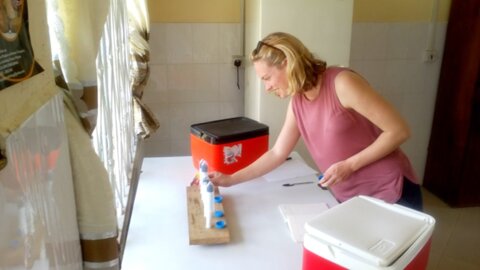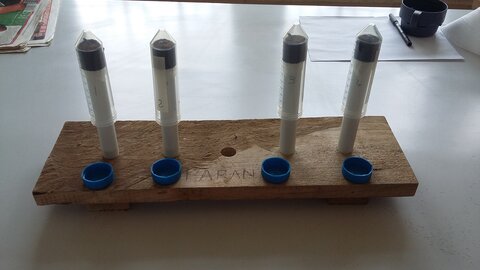How do I know that the insecticide is working?

The best way of being sure that the insecticide is working properly is the close supervision at treatment time, and ensuring that the treatments are repeated at the required intervals. However, if you suspect that something has gone wrong you may want some more direct check on insecticide performance, as below.
Do not waste your time looking for dead flies in the vicinity of treated baits. The flies will have flown well away to die, and when they do fall down they are quickly scavenged by ants.
Unfortunately, there is no way of telling that an insecticide deposit is effective by merely looking at it. Moreover, sending samples of cloth or hair from treated baits will show only how much insecticide is present, without indicating the availabilty of the insecticide to the flies. Hence, bio-assays of the insecticide deposit are necessary.
Critical bioassays require an insectary with a controlled climate to keep the flies alive for several days. Moreover, specialised equipment is needed to expose the flies to treated cloth. However, you can run some crude bio-assays to get a rough idea of the efficacy of the deposits, scoring the percentage knock-down at a few hours after exposure.
Equipment
1. -- A few clean, preferably new, polystyrene boxes to hold the flies after treatment, and clean cloth that can be dampened to put over the box to keep it cool and shaded.
2. -- A hundred or so open-ended glass tubes, about 7.5cm long and 2.5 cm in diameter, to hold individual treated flies. Netting, rubber bands and corks will be required to seal the tubes.
3. -- Small, self-stick labels to indicate the type of treatment for the tubed fly.
4. -- Handnets to catch flies. If you are catching flies from treated oxen you will need to have many nets since each must be discarded for later cleaning and reuse after catching a fly, or after merely attempting to catch a fly from treated animals. This procedure minimises the insecticide contamination of the nets. Buckets of galvanised iron, ie, a readily cleaned material, are handy for carrying large numbers of nets and should be marked clearly to indicate their use for clean and used nets
5. -- Plenty of washing-up liquid, or Teepol, to clean the nets and tubes. The netting from used tubes should be discarded, but the bands and corks can be reused after cleaning. It is safest to abrade away a little of the flat, inside end of the cork, using fine sandpaper.

Exposure of flies to insecticide
You will need to study a minimum of about 30 flies that have been exposed to the test deposit of insecticide, and another 30 "controls", ie, flies that have been caught and handled the same as the treated flies but not exposed to insecticide.
To catch flies from insecticide-treated cattle, station a tame treated ox where plenty of tsetse feed on it and catch flies when they have fed and are about to leave the ox. Quickly remove the fly from the net and place it in a tube. Controls should be caught from an untreated ox that is stationed about 200m away, on the same day or on alternate days.
To expose flies to insecticide-treated targets it is usually most convenient to start with a stock of tubed flies freshly caught from caught from traps or cattle that have not been treated with insecticide. Remove an individual fly from the tube and hold it gently on its back, between your thumb and index finger, so that its legs are free. Then hold the fly gently against the target cloth so that only its legs make contact. After a minute, return the fly to the tube and wash your hands before dealing with another fly. Controls can be obtained by exposing the flies to cloth that has not been treated with insecticide.
Scoring the knock-down
After returning the treated flies and the controls to their tubes, label the tubes and put them in a polystyrene box that is covered in damp cloth and placed in a cool place. Examine the flies at hourly intervals up to four hours after exposure. A knocked-down tsetse is one that does not fly or walk when the tube is gently shaken. Usually the fly is on its back and cannot right itself. The total knock-down in the sample of flies is the sum of individuals that have been knocked-down in at least one of the post-exposure inspections.
You should find that less than 5% of the controls are knocked-down. If the control knock-down is greater than 5% you have been handling the flies too roughly, or exposing them to excessive heat or using equipment that is contaminated with insecticide. Improve your technique and run the study again.
Correction for knock-down
In assessing the percentage knock-down due to the insecticide treatment alone, it is necessary to correct for the knock-down among the controls. This correction is performed by Abbott's formula. Tsetse Plan includes a tool to help you calculate this correction.
References
Torr, S.J., Maudlin, I., Vale, G.A. (2007). Less is more: restricted application of insecticide to cattle to improve the cost and efficacy of tsetse control. Medical and Veterinary Entomology 21(1):53-64. PubMed PMID: WOS:000245546100006.